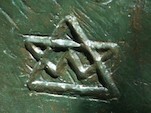

(Montauban, 1861 - Le Vésinet, 1929)

Born in Montauban (Tarn et Garonne) in 1861, Antoine Bourdelle discovered sculpture in his father's workshop, who was a woodcarver. At the age of 15, he received a scholarship for the Academy of Fine Arts in Toulouse.
In 1884, he came to Paris and entered the Ecole des Beaux-Arts, in the studio of the sculptor Alexandre Falguière (1831-1900). He also received much guidance from another sculptor, Jules Dalou.
In 1885, he rented a studio in Montparnasse where he lived and worked until his death: today this studio is the Bourdelle museum. Then, Bourdelle participates for the first time at the Salon des Artistes Français.
From 1891, he exhibited at the Salon of the National Society of Fine Arts.
In 1888, the figure of Beethoven appeared in his works, a motive that he will take again throughout his life.
To earn a living, Bourdelle entered Rodin' studio as a practitioner in 1893, staying there for 15 years (until 1908). Here, a real friendship was established between the two men.
In 1895, he receives from his hometown the command of the Monument aux Morts of Tarn-et-Garonne from 1870 (1897-1900).
First influenced by the art of Rodin, Bourdelle developed his own style in the early 1900s, greatly inspired by archaic Greece.
He rejuvenates the mythological themes: Tête d'Apollon (between 1900 and 1909), Pallas (1905), Herakles Archer (1909), Le Fruit (1902-1911), Penelope (1907-1912), Le Centaure mourant (1911-1914 ), Sappho (1887-1925), La Naissance d'Aphrodite (1924, colored stucco frieze for the top stage of the Opéra de Marseille).
In 1901, Pierre, the son of Bourdelle and Stéphanie Van Parys (whom Bourdelle married in 1904), was born. In 1906, Bourdelle met Cleopatra Sevastos, who became his wife in 1910 and gave him a daughter, Rhodia, in 1911.
His first solo exhibition was held in 1905 at the Galerie Hébrard, rue Royale in Paris. That same year, he exhibited for the first time at the Salon d'automne.
From 1909, Bourdelle gave courses at the Académie de la Grande Chaumière. Among his many students, he trained Alberto Giacometti, Germaine Richier, Vieira da Silva and Otto Gutfreund.
Named Knight of the Legion d'Honneur in 1909, he became an officer in 1919, and a commander in 1924. In 1910, the sculpture Hérakles archer earned him a massive critical and public success.
From 1910 to 1913, he participated in the decor of the Théâtre des Champs-Elysées. He also had a huge success at the Venice Biennale in 1914.
After the war, he executed many commissions for public monuments in France and abroad.
In 1923, he participated in the creation of the Salon des Tuileries.
In 1925, he created a monumental statue of France (a cast on the forecourt of the Palais de Tokyo in Paris).
Bourdelle is also a magnificent portrait painter: Ingres (1908), Rodin (1909), Anatole France (1919), Auguste Perret (1922), Self-Portrait (1929) ...
In the last years of his life, Bourdelle experimented with polychromy, with sculptures such as the La Reine de Sheba and La Jeune Fille de La Roche-Posay.
Bourdelle died on October 1, 1929 in Vésinet, at his friend's house, the Fonderie Rudier.
His sculptures are marked by lyricism, monumentality and architectural character.